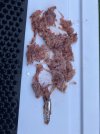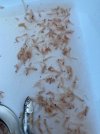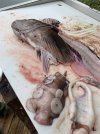You are using an out of date browser. It may not display this or other websites correctly.
You should upgrade or use an alternative browser.
You should upgrade or use an alternative browser.
Whats in my belly?
- Thread starter wildmanyeah
- Start date
ILHG
Crew Member
Krill (Euphasiids) and an anchovy.
Bleed then gut quickly to avoid belly burn on cohoes feeding on krill..
OK, please teach me what belly burn is. I never knew about this.
When fish have full stomach , the contents can start to decompose when the fish is killed and the contents will generate heat which will spoil your catch from the inside out. It is really bad with fish that heave stomachs full of krill and/ or needlefish, but it can and will happen with any stuffed gut. I have seen commercial caught loads of pacific cod spoil even when put in tanks of ice slurry, the decomposing contents in the fish will even raise the temp of the slurry several degrees
Gong Show
Well-Known Member
I understood it to be that the digestive enzymes in a 'carnivore' salmon belly.
When a coho or chinook are killed, the digestive enzymes keep going, while the balance the salmon normally has is now dead.
This is why coho and chinook are cleaned quickly. The situation is worse when their is a belly full of fish or krill being worked on by lots of digestive enzymes.
When a coho or chinook are killed, the digestive enzymes keep going, while the balance the salmon normally has is now dead.
This is why coho and chinook are cleaned quickly. The situation is worse when their is a belly full of fish or krill being worked on by lots of digestive enzymes.
Baxter
Well-Known Member
Interesting. I have been thinking of getting an on-boat cleaning solution setup (table, or something) but haven't yet. Longest fish ever go uncleaned for me is maybe 12 hours on an extreme day, but that is very rare, on average maybe 6 hours or so.
How quickly does "belly burn" tend to occur?
How quickly does "belly burn" tend to occur?
tubber
Well-Known Member
Enzymes, acids, and digesting food will digest the coho stomach lining then start to burn through the lining of the fish near the ribcage on the side the fish is lying on (gravity).
Looks like bruising, then the rib bones can poke out the membrane inside exposing the flesh to all the grossness.
6 hours is too long for a feeding coho.
Looks like bruising, then the rib bones can poke out the membrane inside exposing the flesh to all the grossness.
6 hours is too long for a feeding coho.
Very cool. That is definitely an anchovy and Euphausiids. These are what are correctly referred to as "Krill." In the UVic Adult salmon diet program we often also see mysid shrimp or "True" shrimp that live in the water column, Pasiphaeids and Sergestids, which most fishers would probably call "Krill". The 2020 report for our program is attached with printable datacards and instructions at the end. I encourage folks to participate. We are particularly short of participants in the Lower Mainland. Samples can be dropped off with Bon Chovy in Granville Island or Pacific Angler.caught this hatchery coho at SH today and it’s belly was stuff. Usually there are empty but not this one. It also had a pectoral fin missing. Is there such thing as a pectoral clip? @Bugs
View attachment 71129View attachment 71131
Attachments
AVery cool. That is definitely an anchovy and Euphausiids. These are what are correctly referred to as "Krill." In the UVic Adult salmon diet program we often also see mysid shrimp or "True" shrimp that live in the water column, Pasiphaeids and Sergestids, which most fishers would probably call "Krill". The 2020 report for our program is attached with printable datacards and instructions at the end. I encourage folks to participate. We are particularly short of participants in the Lower Mainland. Samples can be dropped off with Bon Chovy in Granville Island or Pacific Angler.
And on the pectoral clip...no, not outside of experimental treatments. Although, I have seen fish missing one or both pectorals. My theory is these are mostly hatchery fish which have partially or totally rubbed off the fins in tanks as juveniles.caught this hatchery coho at SH today and it’s belly was stuff. Usually there are empty but not this one. It also had a pectoral fin missing. Is there such thing as a pectoral clip? @Bugs
View attachment 71129View attachment 71131
occasionally, local hatcheries have in the past clipped some of their fry to mark them for various purposes - and back in the day of the Mifflin plan which led to the Community Fisheries Developement Centres and Fisheries Renewal funding - the focus was on coho (i.e the coho "crises"). In those days there were many groups looking @ juvie coho densities and clipping various fins for mark and recapture estimates to determine densities. When those clips grew over - the regen part of that fin was clear of rays and one could see the strait scissor clip @ the edge of that regen verses natural regen over the tips of the caudal fin when trout and larger fry nip @ each other.
When I was a commercial salmon troller back in the 70's, I only saw belly burn in coho; not in other species.
That's because of coho's lifecycle; they double or triple their size in their last year at sea. That means they eat and therefore digest, immense amounts of food. To quickly break down and absorb all that food in their guts, they produce huge amounts of powerful digestive enzymes. When they are alive, that's not a problem to them. But as soon as they are killed, digestion stops, and all those unused enzymes then start to dissolve that thin, clearish membrane we see lining the gut cavity, separating the meat from the guts. With belly burn, we see gaps in that membrane, which allow digestive juices to dissolve the meat. Ribs stick out, the meat becomes mushy, and buyers would either give us a lower price, or if the belly burn was bad, refuse the fish.
As a newbie deckhand, it was made very clear to me to clean coho ASAP. And of course, to clean all salmon as soon as possible, because seafood is much, much more perishable than land animal meat.
Another lesson I learned about how powerful coho digestive juices are, was on those days of huge coho catches. Those days meant many, many hours of gutting, and several times I ended up with "coho poisoning", or "coho burn", which is when the thin skin on the back of your hands is basically dissolved. It's painful, red, raw, and oozes pus; like a bad chemical burn.
I shake my head at sport anglers leaving the guts and gills in their salmon for so long. At the very least, remove the gills and let them bleed out, because blood goes bad faster than flesh.
That's because of coho's lifecycle; they double or triple their size in their last year at sea. That means they eat and therefore digest, immense amounts of food. To quickly break down and absorb all that food in their guts, they produce huge amounts of powerful digestive enzymes. When they are alive, that's not a problem to them. But as soon as they are killed, digestion stops, and all those unused enzymes then start to dissolve that thin, clearish membrane we see lining the gut cavity, separating the meat from the guts. With belly burn, we see gaps in that membrane, which allow digestive juices to dissolve the meat. Ribs stick out, the meat becomes mushy, and buyers would either give us a lower price, or if the belly burn was bad, refuse the fish.
As a newbie deckhand, it was made very clear to me to clean coho ASAP. And of course, to clean all salmon as soon as possible, because seafood is much, much more perishable than land animal meat.
Another lesson I learned about how powerful coho digestive juices are, was on those days of huge coho catches. Those days meant many, many hours of gutting, and several times I ended up with "coho poisoning", or "coho burn", which is when the thin skin on the back of your hands is basically dissolved. It's painful, red, raw, and oozes pus; like a bad chemical burn.
I shake my head at sport anglers leaving the guts and gills in their salmon for so long. At the very least, remove the gills and let them bleed out, because blood goes bad faster than flesh.
ILHG
Crew Member
Awesome information. I have had this happen to me a few years back with Coho. They were packed full of crab larvae, to the point the stomach felt like it was full of rocks.
I had the meat go soft on some and the ribs pull away. I was puzzled as they were on ice right away. Only 4hrs or so with guts in them but that was enough I guess.
Glad I learned this today. Never again
I had the meat go soft on some and the ribs pull away. I was puzzled as they were on ice right away. Only 4hrs or so with guts in them but that was enough I guess.
Glad I learned this today. Never again
SpringFever552
Well-Known Member
have no idea why it was still feeding
"because its a ling"
prodjsaig
Well-Known Member
They are territorial and will attack anything lol thats really cool.i found this in the belly of a 12 lb ling caught 10 miles offshore Nootka sound this summer. the leg of this octopus is as big around as my forearm. have no idea why it was still feeding
sly_karma
Crew Member
FIFY. I've pulled an octopus tentacle a metre long out of a ling's stomach yet it still hit the pound-plus black bomber we were using for bait. Insatiable appetite; there's a reason why they're such fast growing fish.They are greedy and will eat anything that fits in their mouth lol thats really cool.
wildmanyeah
Crew Member
FIFY. I've pulled an octopus tentacle a metre long out of a ling's stomach yet it still hit the pound-plus black bomber we were using for bait. Insatiable appetite; there's a reason why they're such fast growing fish.
makes you wonder how much Thoes 40 pound breeders are eating
trophywife
Crew Member
10lb lingsmakes you wonder how much Thoes 40 pound breeders are eating
Similar threads
- Replies
- 13
- Views
- 992
- Replies
- 0
- Views
- 655




